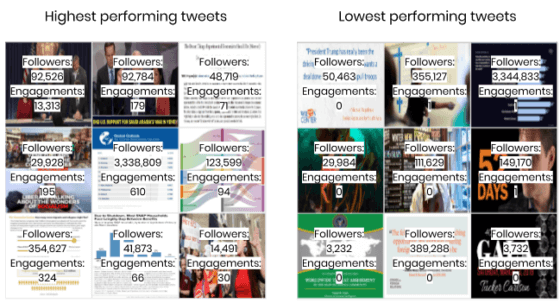Over the past decade, social media rose in prominence due to the speed with which content can be created and shared. This has allowed assertive organizations to capture attention and dominate issue areas. But as more and more players compete in this space, the challenge grows to become ever more clever, clear, and insightful in order to build loyalty among your stakeholders.
To win the social media attention wars, high quality pictures have become a powerful tool.
Producing or selecting images that meet all these criteria can take a tremendous amount of time and energy, however, negating the speed and lightweight effort we associate with social content production. If you are going to put in all that effort, how much of an edge will it really get you—and what can you do to help make sure your images are on the right track?
To support our think tank clients, we reviewed the Twitter content of 130+ policy organizations in order to understand which kinds of messages perform well, and how the use of images affects social media performance.
We work with a lot of #thinktank orgs, and reviewed tweets from more than 130 of their accounts to learn what works. Here are some findings about their images! https://t.co/M2PVfGdMuo #nptech #DigitalMarketing pic.twitter.com/Bz250Ehaj7
— Stefan Byrd-Krueger (@byrdkrueger) February 4, 2019
Think tank tweets with images get 30% more retweets and 40% more likes than plain text or link tweets—but there is a huge and overlapping spread in performance. There are some very effective plain text tweets, and some terribly performing tweets with pictures.
Here is a sample of images just from the last week of January that represent the “best foot forward” from a lot of the think tank community as well as ones that missed the mark.

Some of the best performing tweets introduce visuals and data that capture the interest of their audiences, or highlight provocative facts and claims. Some of the lowest performing tweets, however, present content that may only appeal to a small fraction of their followers, or lack a clear and compelling central point to engage users. Following good journalistic principles to entice and excite your users is critical to driving engagement.
Here is one comparison that really illustrates the impact of these principles: Two tweets, both from the World Economic Forum Twitter account, both presenting a chart comparing geographic trends and comparisons.

The tweet on the left enjoyed one of the highest rates of engagement during the last week of January, featuring a clear and focused comparison and tying itself to the hashtag #gender—a topic with a broad audience. It uses clean and elegant design to make the data shown more appealing and offer at a glance context about what the image is telling you. And importantly, timing was a crucial factor in this tweets success, as it went out in the middle of the Davos forum when the World Economic Forum account was already gaining tremendous traction. The tweet on the right, in contrast, lacked many of these beneficial traits and circumstances, leaving it with a much lower engagement rate.
Some general advice on the use of images on Twitter
There are few best practices in creating “good” images include using high contrast and bold typefaces that make any text easy to read even on small devices, among many other design tips. A lot of think tanks will also use charts and graphics to visualize and simplify complex concepts. Consistency and adherence to brand identity can also help a loyal audience recognize familiar content from an organization they already trust.
In our work with think tanks, we review a lot of policy content, which can be notoriously difficult to visualize. To be successful, social media images need to be:
- Relevant to the content or concept being shared
- Appropriate for the organization’s brand and audience sensibilities
- Compelling; i.e. it grabs audience attention, arouses their interest, and helps them understand what they’ll get by engaging further with content
- Copyright free, meaning you have to create it yourself, or browse oceans of available and often low-quality imagery.
These are just a few lessons we can learn from reviewing only the images from a broad cross-section of think tank Twitter accounts. Keep in mind, though, that images are just one factor in an effective social strategy. Other markers of successful content include contextual text that makes the image relevant or interesting, timeliness of the content in the news cycle, timing of the content in the day or week, and how well the posting account has established itself with its followers.
Even deeper insights can come from studying more targeted groups of users, and from analyzing the text of social media content, as we have explored in the past. There are so many questions we can ask of our data, and social media provides a powerful forum for learning from your peer organizations and the responses of their audiences.





